What are the criteria for choosing stainless steel kitchen
One of the most important sanitary appliances in the house, without which no modern kitchen can do, is a familiar kitchen sink. Currently, they are produced in a wide range of a wide variety of materials, but as practice shows, the most practical and durable, are stainless steel kitchen sinks according to GOST 50851-96, because they have all the necessary consumer qualities, and fully comply with sanitary and hygienic requirements.

Features of the choice of stainless steel sinks
In addition to performing its immediate functions, the kitchen sink is an indispensable addition to the design of the furniture, so ideally, such a product should combine qualities such as reliability, functionality, environmental safety, usability, as well as the original design and attractive appearance.
In order to help the reader deal with the question of choosing a kitchen sink, later in the article a detailed instruction will be presented in which the basic consumer qualities of such products are described in an understandable language, as well as useful tips and advice on choosing a high-quality stainless steel sink.
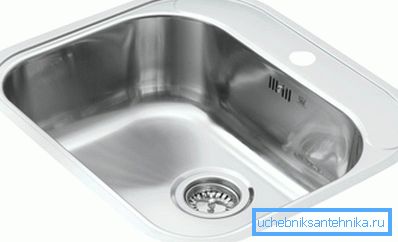
Main advantages and disadvantages
Modern metal sinks have a number of positive qualities that cause their great popularity, both among residents of private houses and their own apartments, as well as among cooks and owners of catering enterprises.
Immediately it should be noted that they are among the plumbing devices that have virtually no flaws, therefore, their main positive properties will be given below.
- The wide availability, relatively low price, and a huge range of products allow you to purchase a quality product to any buyer, to your taste, based on your own needs and personal preferences.
- Stainless steel, as alloying additives, contains a significant amount of chromium and nickel, due to which it has high mechanical strength, is absolutely resistant to corrosion, does not oxidize over time and does not emit harmful substances, and is also hypoallergenic and environmentally friendly. pure material.
- Nickel-chromium steel is not exposed to most acids and alkalis, and also has good resistance to wear and abrasion of solid particles, so any household detergents and cleaning products can be used for daily cleaning and hygienic care of its surface.
- In addition, the metal sink is absolutely not afraid of exposure to high temperatures, as well as their significant differences, so you can safely pour boiling water into it, or put a hot frying pan.

Tip! In order to prevent the metal shell from being deformed due to the uneven exposure to high temperature, products with a metal wall thickness of not less than 0.8 mm should be selected.
Main technical characteristics
When buying any product, its appearance, design, color, shape, and other aesthetic qualities, the future owner chooses, based on their own taste and personal preferences, however, even the most beautiful thing must meet certain conditions and technical requirements.
For this reason, when choosing a stainless steel kitchen sink, you should carefully study its main technical characteristics.
- First of all, you need to pay attention to the material of manufacture. A quality product must necessarily be made of food chromium-nickel steel (grade AISI 304 or 08X18H10), because some unscrupulous manufacturers may use low-grade industrial steel for their manufacture.
- The next important parameter is the thickness of the material. The optimal value is considered to be the thickness of the metal in the range of 0.8-1.0 mm, while a cheap and low-quality product may have a thickness of 0.3 - 0.4 mm, or less.
- The dimensions of the main bowl can vary widely, but the most convenient and large enough is a square sink of stainless steel 500x600 mm, or round - with a diameter of 500 mm.
- The depth of the main bowl, depending on the model, can be from 120 to 250 mm, while the most practical is the useful depth in the range of 160-200 mm.
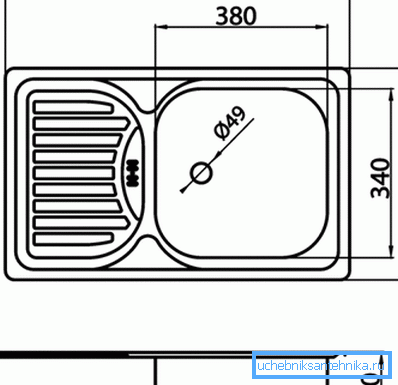
Tip! High-quality stainless steel should have a uniform, smooth glossy surface, with a uniform metallic luster over the entire area, without scratches, vagaries, dull stains, dents, and other visible manufacturing defects. Another feature of a quality steel grade is that it is not attracted by a permanent magnet.
Different designs
Depending on the individual design, and the technical features of the floor cabinet or cabinet, on which the stainless steel kitchen sink will be installed, it can be made in three different versions, which differ from each other both in appearance and in installation method.
- The most voluminous and expensive are the overhead sinks, since they are a single solid table with a stainless steel sink, on the side of which there is usually a panel for draining water from washed dishes or clean products. This option can be used on almost all pedestals, even without a top cover, besides a solid metal surface reliably protects the tabletop from moisture and mechanical damage.
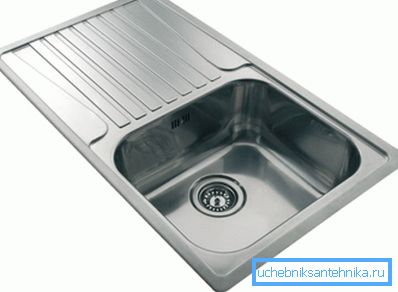
- A mortise metal sink is considered to be more accessible and simple, which is installed in a pre-cut hole of the required shape, which is pre-cut in the tabletop, and is fixed from the inside with the help of special clamps, which are supplied. The main advantage of the mortise models is a relatively low cost, as well as the ability to install by hand, almost any ready-made tabletop.
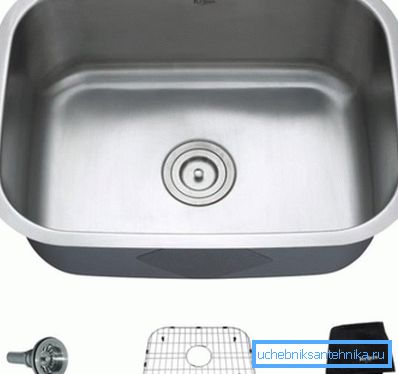
- Special attention is given to integrated sinks, which are a combined worktop for a kitchen floor cabinet with built-in stainless steel sink. A distinctive feature of such models is that they can only be installed on countertops made of artificial or natural stone.
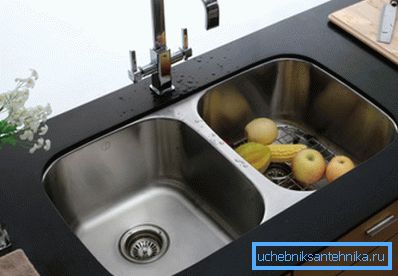
Technological features of manufacturing
At present, two completely different technologies can be used for the industrial manufacture of metal sinks, therefore, depending on the technological process, all stainless steel sinks are divided into two types.
- Seamless steel shells are made by hot stamping and extrusion of the entire finished product from a single sheet of metal. This technology allows more economical use of the material, however, during the production process, significant internal stresses arise in the thickness of the metal, moreover, the depth of such products cannot be more than 150-200 mm.
- If the buyer needs a deep sink of stainless steel, you should pay attention to welded metal sinks. During their production, the bowl and the base are made separately, and then they are welded in an inert gas stream, after which the weld is subjected to grinding and polishing, and becomes almost imperceptible.
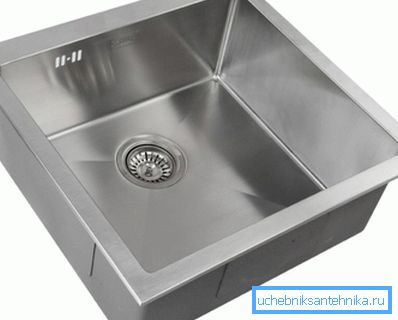
Conclusion
In conclusion, it should be recalled that installing mortise stainless steel sinks, you need to carefully seal the joint between the base of the sink, and the surface of the tabletop to prevent water from entering the unprotected end of the chipboard. More visual information on this issue can be seen in the presented video in this article, or read in other sections of this site.